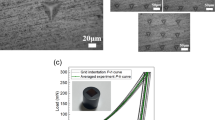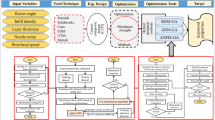Abstract
This study aimed to develop a semi non-parametric model of the die casting process of aluminum alloys. This model uses a hierarchical artificial neural network (HANN), with a structure motivated by the relationships of the metals which define the characteristics of the aluminum alloy. These settings depend on the content of seven metals (Sn, Zn, Mn, Cu, Si, Ni, and Mg). The relation between these metals and the alloy characteristics oriented the HANN structure. A distributed back-propagation learning modified with the Levenberg-Marquardt method served to adjust the HANN weights. Two complementary validation methods justified the application of this novel hybrid non-parametric modelling structure. The training set came from standards composition proposed by different international organizations. A set of real aluminum alloys and the experimental results describing their characteristics formed the validation test. An average accuracy value of 3.65% confirmed the ability of the HANN to reproduce the relation between the metal content and the alloy characteristics. These values confirmed how the oriented HANN may predict the aluminum alloy characteristics as function of the metal distribution. This result offers a different alternative to the prediction of aluminum alloy properties using the metal composition as input information.



Similar content being viewed by others
References
Multi-objective design and optimization of hard magnetic alloys free of rare earths, Materials Science & Technology Conference and Exhibition 2015 (MS&T’15), vol 1. Curran Associatives (2015)
Campanella B, Grifoni E, Legnaioli S, Lorenzetti G, Pagnotta S, Sorrentino F, Palleschi V (2017) Classification of wrought aluminum alloys by artificial neural networks evaluation of laser induced breakdown spectroscopy spectra from aluminum scrap samples. Spectrochim Acta B At Spectrosc 134:52–57
Canakci A, Varol T, Ozsahin S (2015) Artificial neural network to predict the effect of heat treatment, reinforcement size, and volume fraction on alcumg alloy matrix composite properties fabricated by stir casting method. Int J Adv Manuf Technol 78(1–4):305–317
Cerri R, Barros RC, de Carvalho AC (2014) Hierarchical multi-label classification using local neural networks. J Comput Syst Sci 80(1):39–56. https://doi.org/10.1016/j.jcss.2013.03.007. http://www.sciencedirect.com/science/article/pii/S0022000013000718
Dursun T, Soutis C (2014) Recent developments in advanced aircraft aluminium alloys. Mater Des (1980-2015) 56:862–871
Ezugwu E, Fadare D, Bonney J, DaSilva R, Sales W (2005) Modelling the correlation between cutting and process parameters in high-speed machining of inconel 718 alloy using an artificial neural network. Int J Mach Tools Manuf 45:1375–1385
Hirsch J (2014) Recent development in aluminium for automotive applications. Trans Nonferrous Metals Soc Chin 24(7):1995–2002. https://doi.org/10.1016/S1003-6326(14)63305-7. http://www.sciencedirect.com/science/article/pii/S1003632614633057
Karabulut Ş (2015) Optimization of surface roughness and cutting force during aa7039/al2o3 metal matrix composites milling using neural networks and taguchi method. Measurement 66:139– 149
Kaufman G, Rooy E (2004) Aluminum alloy properties: properties, porcesses, and applications. ASM International
Kawato M, Furukawa K, Suzuki R (1987) A hierarchical neural-network model for control and learning of voluntary movement. Biol Cybern 57(3):169–185
Koli DK, Agnihotri G, Purohit R (2015) Advanced aluminium matrix composites: the critical need of automotive and aerospace engineering fields. Mater Today: Proc 2(4):3032–3041. https://doi.org/10.1016/j.matpr.2015.07.290 http://www.sciencedirect.com/science/article/pii/S2214785315005350. 4th International Conference on Materials Processing and Characterzation
Malinov S, Sha W, McKeown J (2001) Modelling the correlation between proprocess parameters and properties in titanium alloys using artificial neural networks. Comput Mater Sci 21:375–394
Manjunath P, Prasad K, Mahesh P (2016) An intelligent system for squeeze casting process—soft computing based approach. Int J Adv Manuf Technol 86:3051–3065
Maren A, Harston C, Pap R (2014) Handbook of neural computing applications. Academic Pres
Mavrovouniotis M, Chang S (1992) Hierarchical neural networks. Comput Chem Eng 16 (4):347–369. https://doi.org/10.1016/0098-1354(92)80053-C, http://www.sciencedirect.com/science/article/pii/009813549280053C. Neutral network applications in chemical engineering
Mirzadeh H, Najafizadeh A (2008) Correlation between processing parameters and strain-induced martensitic transformation in cold worked aisi 301 stainless steel. Mater Charact 59(11):1650–1654
Mitterer C, Holler F, Ustel F, Heim D (2000) Application of hard coatings in aluminium die casting — soldering, erosion and thermal fatigue behaviour. Surf Coatings Technol 125:233–239
Muñoz-Ibáñez C, Alfaro-Ponce M, Perez-Lechuga G, Pescador-Rojas JA (2018) Design and application of a quantitative forecast model for determination of the properties of aluminum alloys used in die casting. Int J Met, 1–14
NADCA (2015) Product specification standards for die casting, 9 edn. North American Die Casting Association
Panchal J, Kalidindi S, McDowell D (2013) Key computational modeling issues in integrated computational materials engineering. Comput Aided Des 45:4–25
Park Y, Cho H (2005) A fuzzy logic controller for the molten steel level control of strip casting processes. Control Eng Pract 13(13):821–834
Ruiz ME, Srinivasan P (1999) Hierarchical neural networks for text categorization (poster abstract). In: Proceedings of the 22Nd annual international ACM SIGIR conference on research and development in information retrieval, SIGIR ’99. ACM, New York, pp 281–282, https://doi.org/10.1145/312624.312700
Sharma A, Tuzel O, Jacobs DW (2015) Deep hierarchical parsing for semantic segmentation. In: Proceedings of the IEEE conference on computer vision and pattern recognition, pp 530–538
Thirumalaikumarasamy D, Balasubramanian V, Sabari S, Vignesh S (2017) Comparison of artificial neural networks (ann) and response surface methodology (rsm) modeling approaches in predicting the deposition efficiency of plasma sprayed alumina coatings on az31b magnesium alloy. J Adv Microsc Res 12(1):40–49
Varol T, Canakci A, Ozsahin S (2015) Modeling of the prediction of densification behavior of powder metallurgy al–cu–mg/b4c composites using artificial neural networks. Acta Metallurgica Sinica (English Letters) 28 (2):182–195
Zheng J, Wang Q, Zhao P, Wu C (2009) Optimization of high-pressure die-casting process parameters using artificial neural network. Int J Adv Manuf Technol 44:667–674
Author information
Authors and Affiliations
Corresponding author
Additional information
Publisher’s note
Springer Nature remains neutral with regard to jurisdictional claims in published maps and institutional affiliations.
Rights and permissions
About this article
Cite this article
Munõz-Ibañez, C., Alfaro-Ponce, M. & Chairez, I. Hierarchical artificial neural network modelling of aluminum alloy properties used in die casting. Int J Adv Manuf Technol 104, 1541–1550 (2019). https://doi.org/10.1007/s00170-019-04019-z
Received:
Accepted:
Published:
Issue Date:
DOI: https://doi.org/10.1007/s00170-019-04019-z




